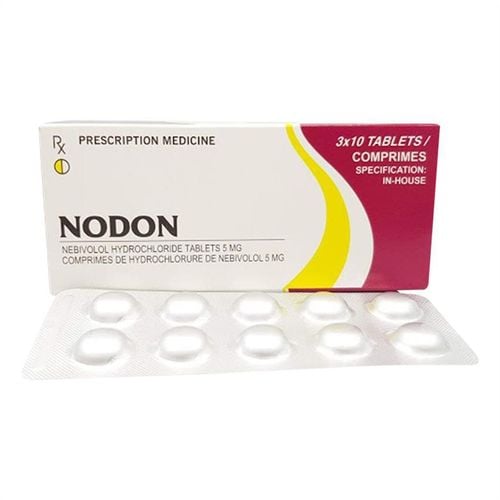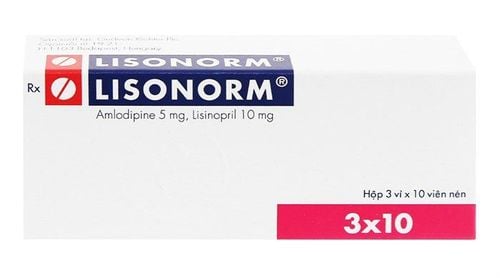This is an automatically translated article.
Amesartil 300 belongs to the group of cardiovascular drugs, is made in the form of tablets packed in boxes and has the main ingredient is Irbesartan 300mg. The following article provides readers with detailed information about uses, usage and notes when using Amesartil 300 drug line.
1. What are the effects of Amesartil 300?
Amesartil 300 is used in the following cases:
Treatment of essential arterial hypertension. Type II diabetic nephropathy with hypertension.
2. Dosage, how to use Amesartil 300
2.1. How to take Amesartil 300 Amesartil 300 is used orally, can be taken with or without meals.
2.2. Dosage of Amesartil 300 Adults:
The recommended starting and maintenance dose is usually 150mg Irbesartan x 1 time/day. A dose of 150 mg of Irbesartan is generally more effective in controlling blood pressure over 24 hours than a dose of 75 mg of Irbesartan. However, a dose of 75 mg Irbesartan may be considered, especially in hemodialysis, volume-depleted patients and patients >75 years of age. In patients unable to adequately control blood pressure with 150 mg of irbesartan, the dose may be increased to 300 mg of irbesartan or additional antihypertensive agents may be used. In particular, when adding a diuretic such as hydrochlorothiazide for synergistic effects with irbesartan. In hypertensive type II diabetic patients, initiation of irbesartan 150 mg once daily and titrated to 300 mg irbesartan once daily - maintenance dose of irbesartan is preferred for treatment kidney disease. The renal benefits of Irbesartan in hypertensive type II diabetic patients were based on clinical studies when Irbesartan was added to other antihypertensive agents. Where necessary, to achieve the desired antihypertensive effect. Renal impairment:
No dose adjustment of Amesartil 300 is required for patients with renal impairment. Initiation with a lower dose (75 mg of Irbesartan) should be considered for patients on hemodialysis. The patient is hypovolemic. Consider a starting dose of 75 mg Irbesartan once daily. Hepatic impairment:
No dose adjustment of Amesartil 300 is required for patients with mild and moderate hepatic impairment. There is no experience of use in patients with severe hepatic impairment Elderly:
Although initiation of Irbesartan 75 mg should be considered in patients over 75 years of age, dose adjustment of Irbesartan is not usually necessary when administered to patients. elderly disease. Children:
The safety and effectiveness of Irbesartan in the 0-18 years old age group have not been established. Therefore, Amesartil 300 is not recommended for this group of people. 2.3. Treatment of Overdose Amesartil 300 Doses up to 900 mg of Irbesartan administered to adults for 8 weeks did not cause any toxicity. In case of overdose, clinical symptoms are hypotension and tachycardia or bradycardia.
There are currently no specific data on the treatment of overdose with Irbesartan. Patients need to be monitored and treated with supportive symptoms. In case of overdose Amesartil 300 can use some measures such as induce vomiting, gastric lavage, activated charcoal.
3. Contraindications to using Amesartil 300
Amesartil 300 should not be used in the following cases:
Patients with hypersensitivity, history of allergy to Irbesartan or to any of its ingredients. Co-administration of Irbesartan and aliskiren-containing drugs in patients with diabetes mellitus and renal failure. Pregnant women in the second and third trimesters of pregnancy.
4. Drug interactions Amesartil 300
Amesartil 300 when used with some drugs can cause interactions such as:
When Irbesartan is combined with other diuretics and antihypertensives, the antihypertensive effect of Irbesartan may be increased. However, Irbesartan is not problematic when combined with some other antihypertensive drugs, such as long-acting calcium blockers, beta blockers or thiazide diuretics. Pre-treatment with high-dose diuretics may increase the risk of hypotension or hypovolemia when initiating irbesartan therapy. Potassium-containing preparations or potassium-sparing diuretics: Concomitant use of Irbesartan with potassium-sparing diuretics or preparations may cause hyperkalemia. Therefore, the combination of Amesartil 300 with these drugs is not recommended. There have been reports of increased blood levels and toxicity of lithium in combination with ACE inhibitors. Similar effects have also been reported with irbesartan, although very rarely. Therefore, the combination of these two drugs should be avoided. If co-administration is necessary, close monitoring of serum lithium levels is paramount. ACE inhibitors and aliskiren-containing drugs: Clinical data suggest that dual blockade of the RAAS system with the combined use of angiotensin II antagonists, ACE inhibitors or aliskiren increases the incidence of adverse events. such as hypotension, decreased renal function (including renal failure) and hyperkalemia compared with the use of a single agent acting on the RAAS system. Therefore, the combination of Amesartil 300 with these drugs is not recommended. If dual blockade therapy is necessary, Amesartil 300 should only be used under the supervision of a physician and with frequent monitoring of renal function, electrolytes, and blood pressure. Concomitant use of ACE inhibitors and angiotensin II antagonists is not recommended in patients with diabetic nephropathy. Co-administration of Irbesartan with non-steroidal anti-inflammatory drugs: When angiotensin II antagonists are co-administered with nonsteroidal anti-inflammatory drugs such as acetylsalicylic acid (> 3g/day), selective cyclooxygenase type 2 inhibitors (COX-2) and non-selective non-steroidal anti-inflammatory drugs, the antihypertensive effect of Amesartil 300 may be reduced. As with ACE inhibitors, concomitant use of Angiotensin II antagonists and non-selective non-steroidal anti-inflammatory agents may increase the risk of impaired renal function, acute renal failure, and hyperkalemia, particularly especially in patients with impaired renal function before treatment. The combination must be cautious, especially in the elderly. Patients must be monitored for renal function after the initiation of the combination and periodically thereafter, in addition, adequate hydration is required. In clinical studies, the pharmacokinetics of Irbesartan was not altered by concomitant administration of hydrochlorothiazide. Irbesartan is metabolised primarily by CYP2C9 and to a lesser extent by glucuronic conjugation. No significant drug interactions were observed when irbesartan was co-administered with warfarin, which is metabolised by CYP2C9. The effect of inducers of CYP2C9, such as rifampicin, on the pharmacokinetics of irbesartan has not been evaluated. The pharmacokinetics of Digoxin were not changed when co-administered with Irbesartan.
5. Side effects when using Amesartil 300
Amesartil 300 may cause some unwanted side effects, which are usually mild and transient, as follows:
Very common: Hyperkalemia in patients with diabetic hypertension. Common: Dizziness, orthostatic hypotension, nausea, vomiting, musculoskeletal pain, fatigue, increased serum creatine kinase, decreased hemoglobin. Uncommon: Tachycardia, flushing, cough, diarrhea, dyspepsia/heartburn, jaundice, sexual dysfunction, chest pain, thrombocytopenia, angioedema, rash, urticaria, hyperkalemia, flowers eyes, headache, tinnitus, taste disturbance, hepatitis, abnormal liver function, leukopenia vasculitis, arthralgia, myalgia, impaired renal function, renal failure. In addition, when using Amesartil 300 on children, there may be some side effects such as headache, dizziness, cough, low blood pressure, increased creatinine and increased creatine kinase.
Amesartil 300 may cause other unwanted effects. Patients need to closely monitor and inform their doctors and pharmacists of all unwanted effects encountered during treatment with Amesartil 300.
6. Precautions when using Amesartil 300
Patients should carefully refer to the instruction sheet for Amesartil 300 and some notes below:
Patients with intravascular volume depletion should use Irbesartan with caution. In patients with hypovolemia, such as dehydration and salt loss due to strong diuretics, diarrhea or vomiting, and dietary salt restriction, symptomatic hypotension may occur, especially after oral doses of irbesartan. firstly. Irbesartan should be used with caution in hypertensive patients with renal artery stenosis because of the increased risk of severe hypotension and impaired renal function. Irbesartan should be used with caution in patients with renal failure and renal transplantation. Patients should be periodically monitored for serum potassium and creatinine when taking irbesartan. Hypertension in patients with type II diabetes and renal disease: The effects of both renal and cardiovascular irbesartan were not consistent across all subgroups in a study of patients with advanced renal disease, typically This effect is less common in women and people of color. Hyperkalemia may occur during treatment with Irbesartan, especially in the presence of renal failure or proteinuria due to renal disease, heart failure, diabetes mellitus. Closely monitor serum potassium in these patients. Irbesartan should not be used in combination with lithium. Irbesartan should be used with caution in patients with mitral stenosis, aortic stenosis or hypertrophic obstructive cardiomyopathy. Patients with primary hyperaldosteronism usually do not respond to antihypertensive agents acting through inhibition of the renin-angiotensin system. Therefore, the use of Amesartil 300 is not recommended for these patients. Patients whose vascular tone and renal function depend mainly on RAAS activity, such as patients with severe congestive heart failure, renal disease, or renal artery stenosis, should be treated with angiotensin receptor antagonists. II or ACE inhibitors acting on this system may cause hypernatremia, acute hypotension, oliguria or acute renal failure (rarely). As with any antihypertensive drug, excessive antihypertensive in patients with ischemic heart disease or ischemic cardiovascular disease can lead to myocardial infarction or stroke. The use of Amesartil 300 in children is not recommended because there are insufficient data on safety and efficacy. Amesartil 300 is not recommended during pregnancy. When pregnancy is detected, treatment with irbesartan should be stopped immediately and treatment with another drug should be substituted. There are no adequate data on the use of Irbesartan during lactation. The effects of Amesartil 300 on the ability to drive and use machines, work at height or otherwise have not been studied. Irbesartan does not impair the patient's ability to drive and use machines. However, Amesartil 300 still causes some side effects such as dizziness, headache that have been reported when used with Irbesartan. Therefore, it is necessary to use caution while driving or operating machinery while the above symptoms persist. The article has provided information about what Amesartil 300 is, dosage and precautions for use. To ensure safety for your health and maximize the effectiveness of your treatment, you need to take Amesartil 300 exactly as directed by your doctor.
Please dial HOTLINE for more information or register for an appointment HERE. Download MyVinmec app to make appointments faster and to manage your bookings easily.













